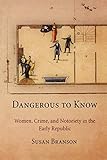Dangerous to Know : Women, Crime, and Notoriety in the Early Republic / Susan Branson.
Material type: TextPublisher: Philadelphia : University of Pennsylvania Press, [2013]Copyright date: ©2008Description: 1 online resource (200 p.) : 8 illusContent type:
TextPublisher: Philadelphia : University of Pennsylvania Press, [2013]Copyright date: ©2008Description: 1 online resource (200 p.) : 8 illusContent type: - 9780812221879
- 9780812201420
- Female offenders -- Pennsylvania -- Philadelphia -- Biography
- Sex role -- United States -- History -- 19th century
- Women authors, American -- 19th century -- Biography
- Women -- Pennsylvania -- Philadelphia -- Biography
- American Studies
- HISTORY / United States / Revolutionary Period (1775-1800)
- American History
- American Studies
- Gender Studies
- Women's Studies
- 305.48/9623092274811 B 22
- HQ1439.P5 B73 2008eb
- online - DeGruyter
- Issued also in print.
| Item type | Current library | Call number | URL | Status | Notes | Barcode | |
|---|---|---|---|---|---|---|---|
 eBook
eBook
|
Biblioteca "Angelicum" Pont. Univ. S.Tommaso d'Aquino Nuvola online | online - DeGruyter (Browse shelf(Opens below)) | Online access | Not for loan (Accesso limitato) | Accesso per gli utenti autorizzati / Access for authorized users | (dgr)9780812201420 |
Frontmatter -- Contents -- PREFACE -- 1. TWO WORKING WOMEN -- 2. MARRIAGE, MANHOOD, AND MURDER -- 3. THE "ENRAGED TYGRESS" -- 4. COURTING NOTORIETY -- 5. AN UNSUITABLE JOB FORA WOMAN -- 6. BETRAYAL AND REVENGE -- AFTERWORD -- NOTES -- INDEX -- ACKNOWLEDGMENTS
restricted access online access with authorization star
http://purl.org/coar/access_right/c_16ec
In 1823, the History of the Celebrated Mrs. Ann Carson rattled Philadelphia society and became one of the most scandalous, and eagerly read, memoirs of the age. This tale of a woman who tried to rescue her lover from the gallows and attempted to kidnap the governor of Pennsylvania tantalized its audience with illicit love, betrayal, and murder.Carson's ghostwriter, Mary Clarke, was no less daring. Clarke pursued dangerous associations and wrote scandalous exposés based on her own and others' experiences. She immersed herself in the world of criminals and disreputable actors, using her acquaintance with this demimonde to shape a career as a sensationalist writer.In Dangerous to Know, Susan Branson follows the fascinating lives of Ann Carson and Mary Clarke, offering an engaging study of gender and class in the early nineteenth century. According to Branson, episodes in both women's lives illustrate their struggles within a society that constrained women's activities and ambitions. She argues that both women simultaneously tried to conform to and manipulate the dominant sexual, economic, and social ideologies of the time. In their own lives and through their writing, the pair challenged conventions prescribed by these ideologies to further their own ends and redefine what was possible for women in early American public life.
Issued also in print.
Mode of access: Internet via World Wide Web.
In English.
Description based on online resource; title from PDF title page (publisher's Web site, viewed 24. Apr 2022)


